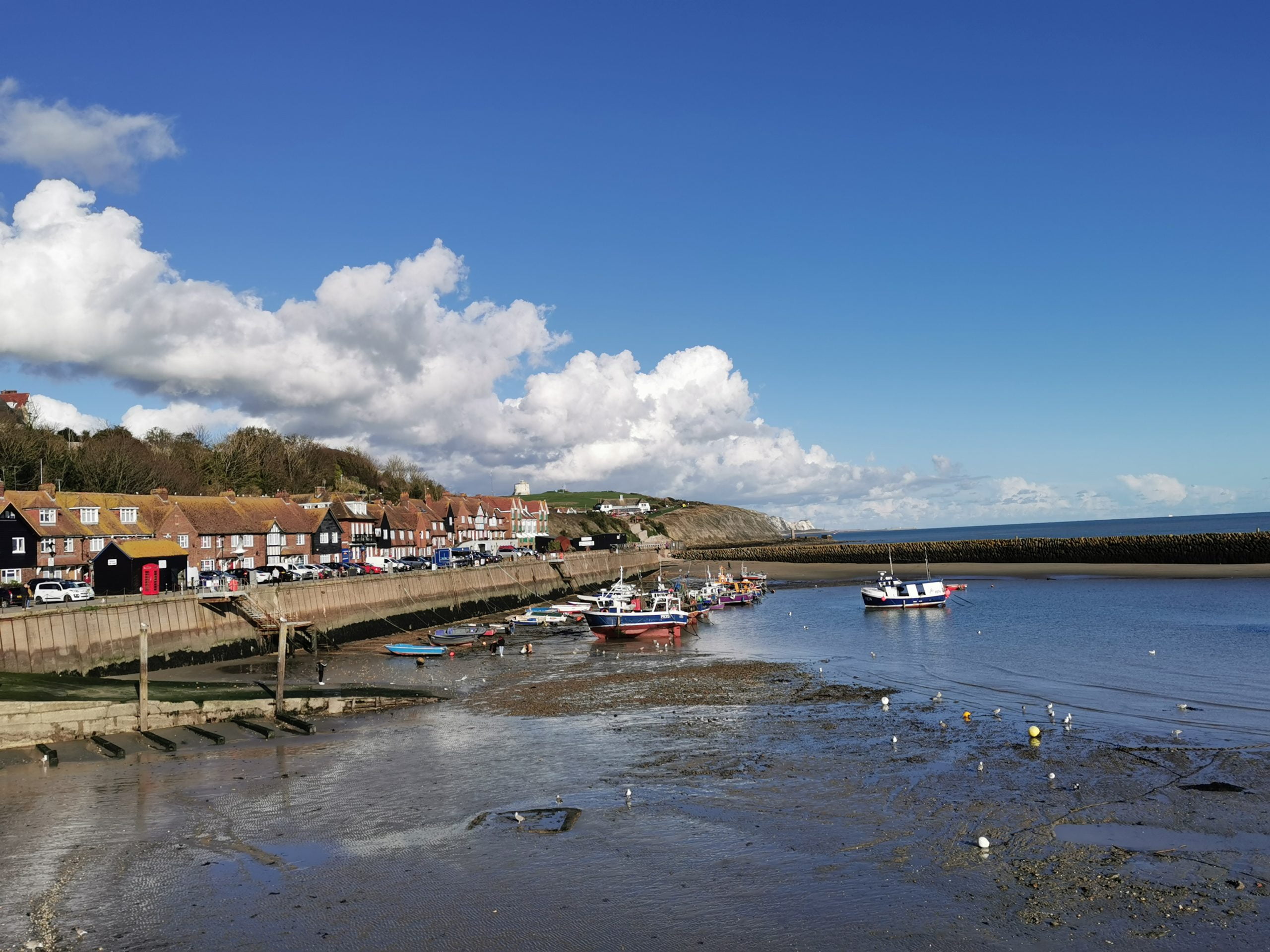No filter needed.



Did you know Banksy lives in Folkestone?

I can’t blame Banksy. It’s around the corner from Harbour Arm.

To get to Folkestone Arm, you need to walk along a disused railway…


Warning. If you’re planning to visit Folkstone, a lot of shops and for spots are closed on Tuesday (which is when we went unfortunately!).
Luckily, Shesells Seashells (great name) was open and had French fries with truffle salt (which were divine).
https://www.instagram.com/p/CUme1vqMJMO/
And we had this view which made it even better. I see a crocodile in between two elephants. What do you see?


More colour and walking around Folkestone Harbour.








There are a lot of quirky independent shops on the Old High Street.



I can recommend the salted caramel hot chocolate at Folklore!

By law, every room should have this many disco balls.

Safe to say I love Folkestone!


Except for the giant seagulls!
History of Folkestone Harbour
Folkestone Harbour is a historic maritime gateway on the Kent coast, with roots stretching back to Roman times. Its modern story began in 1807 when an Act of Parliament allowed the construction of a stone harbour to replace storm-damaged wooden jetties. Civil engineers William Jessop and Thomas Telford designed the piers, completed by 1820, creating a sheltered basin for fishing and trade.
In 1843, the South Eastern Railway transformed the harbour into a major cross-Channel port, launching ferry services to Boulogne and integrating rail-sea connections between London and Paris. During both World Wars, Folkestone Harbour became a vital embarkation point for troops, mail, and refugees — over 9 million passed through between 1914 and 1919. The Harbour Arm, completed in 1904, played a central role in this effort.
After ferry services ceased in 2001, the harbour was reborn as a vibrant leisure destination. Today, it blends heritage with food, art, and seaside charm.
10 Interesting Facts About Folkestone Harbour
- The Harbour Arm was built between 1897 and 1904 using poured concrete faced with granite.
- Folkestone Harbour Station once hosted one of the steepest railway gradients in Britain.
- Over 9.7 million troops and Red Cross workers passed through during WWI.
- The first telegraphed conversation from sea to land occurred here in 1849.
- Spy Mata Hari was intercepted at the harbour in 1915.
- The Great Gold Robbery of 1855 involved bullion stolen from the London–Folkestone boat train.
- The Harbour Arm Lighthouse now houses a Champagne Bar.
- The Mole Café served free tea to troops during WWI, staffed by local volunteers.
- The harbour’s railway station has been repurposed as a promenade and event space.
- Artist Antony Gormley’s sculpture “Another Time XVIII” stands on a submerged landing stage.
Things to See and Do at Folkestone Harbour
- Stroll the Harbour Arm
Walk along the historic pier for panoramic views of the sea, cliffs, and town. Enjoy street food, live music, and pop-up bars along the way. - Visit the Lighthouse Champagne Bar
Sip bubbly at the end of the Arm in a restored lighthouse with 360° views — a unique spot for sunset drinks. - Explore the Harbour Station Promenade
Wander the old railway platform, now a landscaped walkway with art installations and seating. - Discover the Creative Quarter
Just steps away, find galleries, studios, and indie shops in Folkestone’s revitalised Old High Street. - Attend Outdoor Screenings
Catch classic films and sports events at the Harbour Screen in the Goods Yard. - Try Local Street Food
Sample seafood, pizza, tacos, and more from rotating vendors — many with sea views and outdoor seating. - Enjoy Live Music and Events
From jazz to DJs, the Harbour Arm hosts performances throughout the year, especially in summer. - Visit the Sunday Market
Browse artisan crafts, vintage finds, and local produce at weekend stalls. - Play Mini Golf at Beachside
Challenge friends to a round on the 12-hole course with sea views and quirky obstacles. - Relax at the Pilot Beach Bar
Enjoy craft beers and cocktails in a laid-back setting right on the shingle beach.
Practical Information For Visiting Folkestone Harbour
- Location: Harbour Approach Road, Folkestone, Kent CT20 1QH
- Opening times: Harbour Arm open daily for promenading; food and drink vendors vary (typically 11:00 am – 10:00 pm)
- Entry: Free; events and screenings may have separate fees
- Parking: Paid ANPR parking on site; pay at exit or online here
- Accessibility: Most areas accessible; some uneven surfaces due to historic structures
- Dogs: Welcome on leads; not permitted in all indoor venues
- Food: Wide range of cafés, bars, and street food stalls
- Toilets: Available, including accessible facilities
- Nearby: Creative Quarter, Sunny Sands Beach, Lower Leas Coastal Park, Folkestone Museum
- Official website: Folkestone Harbour
Looking for more interesting things to do in Kent?
More guides on Kent
- Best Things To See, Do And Eat In Whitstable
- Best Things To See, Do And Eat In Folkestone
- Best Things To See, Do And Eat In Faversham
- Best Things To See, Do And Eat In Deal
- Best Things To See, Eat And Shop In Broadstairs
- 48 Hours In Margate – Fun & Unique Things To Do
- Best Castles In Kent
- Where Are The Oldest Castles In Kent?
- A Guide To Kent’s Sandy Beaches (And What To See And Do Afterwards)
- Best Coastal Towns In Kent
- In Photos: Why Dungeness Is Worth Visiting – Things To Do & History
- In Photos: A Walk Around Samphire Hoe Country Park & Beach
- Visit Edenbridge: Ultimate Guide To Things To Do












